Flash flooding is caused by a sudden and heavy downpour of rain that causes water to accumulate in certain areas, and/or rivers and streams to overflow.
In such cases the ground and drainage systems cannot drain the water fast enough.
There is often limited time to warn the public.
Flash flooding can cause havoc for motorists, and in some cases can be life threatening.
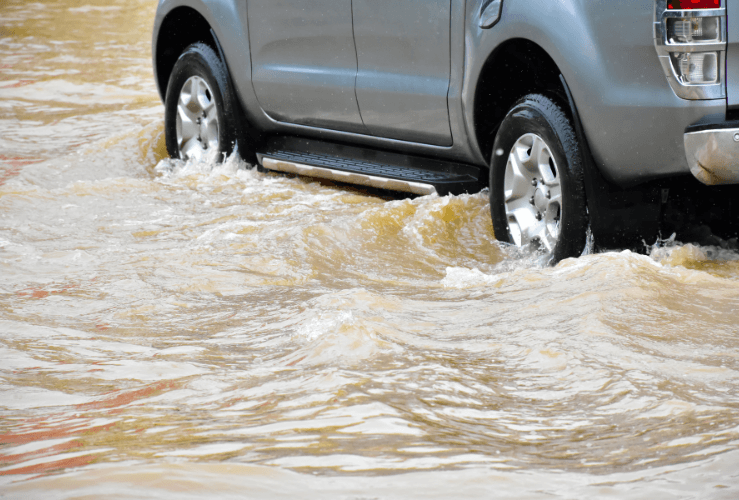
Do not drive if flash flooding is forecast
If there is a flash flood warning, do not drive until the Environment Agency or news reports tell you the flood water has receded.
Check for flood warnings on GOV.UK.
What to do if a flash flood happens while you are driving
If there are signs of flash flooding in the area you are driving, or if weather reports say they are imminent, head to higher ground immediately.
If you find yourself in a patch of flood water, avoid low-lying areas such as railway underpasses, river fords and storm drains. These areas are liable to rapid flooding.
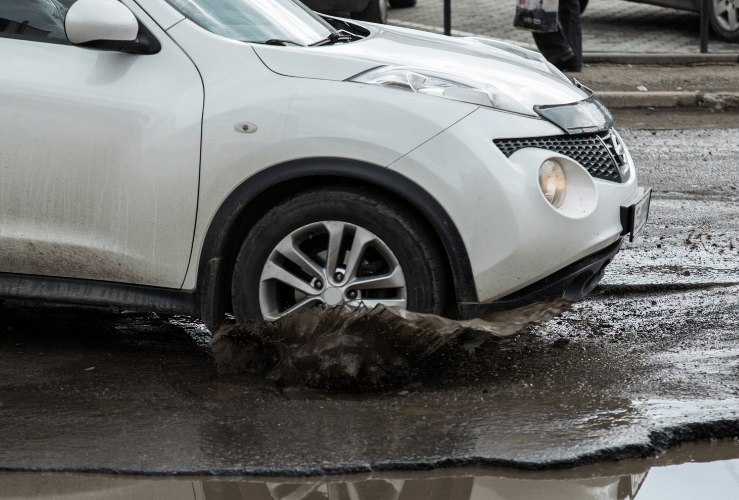
Avoid puddles
As innocuous as puddles may appear, they can conceal potholes and road surface damage. More importantly, it's difficult or impossible to know how deep the water is.
Potholes could damage your vehicle, and deep water could, in extreme cases, see your vehicle immobilised.
Driving through deep puddles and fords can cause water to be sucked into your vehicle's air intake, which can lead to immediate and irreparable engine damage - potentially leaving you stranded in the water.
As little as six inches of water can stall your car; two feet of water could sweep your vehicle away. Even SUVs and trucks can suffer the same fate.
What to do if your vehicle is immobilised in water
If your vehicle is stuck in water and won’t proceed, leave the vehicle straight away and head for higher ground on foot.
In rare cases, power lines may have been brought down, which brings the risk of electrocution.
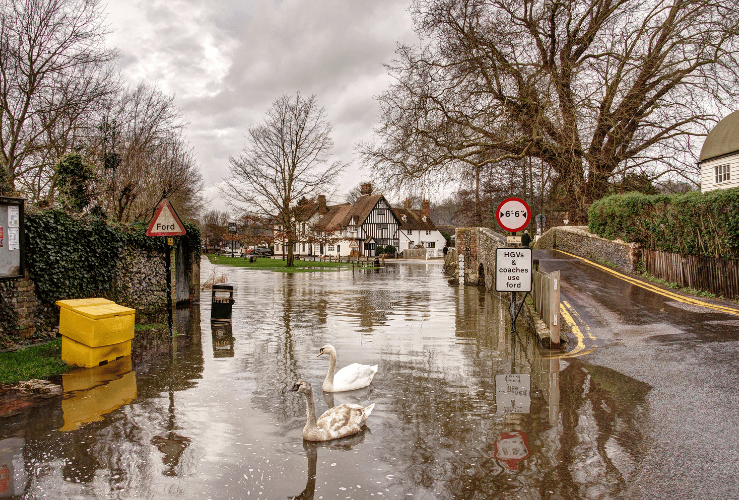
Dealing with fords when water levels rise
Some fords may become impassable after heavy rainfall. A case in point is Rufford ford in Nottinghamshire, where vehicles often get stuck.
While videos of cars being immobilised at Rufford - and in some cases becoming afloat – are now an internet phenomenon, they underline how dangerous some fords can be after heavy downpours.
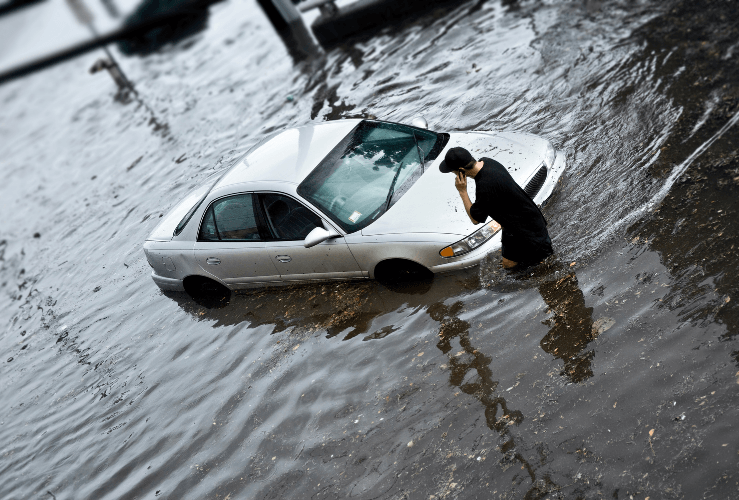
Take care when walking in water
Even a shallow area of water can make walking difficult. Movement can be even more difficult if the water is moving.
Extra care should be taken if you find yourself stuck in a ford, since the river water could sweep you away.
Do not restart the engine
If your car has stopped in water, do not attempt to restart the engine since this will likely cause even more damage.
Only attempt to recover your vehicle once the flood water has receded, using a towing service if necessary.
Escaping a sinking/submerged vehicle
While unlikely, it's possible to find yourself in a sinking or submerged vehicle during a flash flood.
However challenging it may seem, try to remain calm. Panicking will only make escape more difficult.
Take deep breaths and turn on the lights, if they still work. This will also make it easier for rescuers to see you.
If the water level is rising up your car door, it will be almost impossible to open; up to 600 pounds per square inch of pressure will be exerted on the door.
Instead, most advice states you should unbuckle your seatbelt - and tell any other occupants to do the same.
Take care not to get tangled in the released seatbelt; the retraction system may not work.
To ease the escape of other passengers, remove the seat headrests if possible.
Next, open the window and exit the vehicle
Electric windows should still work unless the vehicle is entirely submerged.
If the windscreen shatters, use the gap to escape through if it is safe to do so.
Assist other passengers to escape and then move to higher ground.
Climb on top of your car as a last resort
In general, once outside your car, it's best not to use it as an anchor, or to climb on the roof and await help. However, if there is no higher ground nearby, or the water is moving swiftly, it can be used as a last resort.
Note that a sinking car will go down at the heavier end - where the engine is located. In very deep water, this can cause the vehicle to flip over.
A water bubble is likely to form at the rear, but you should try and stay at the front, where it is easier to escape through the windscreen.
And it goes without saying you should leave all valuables; saving human life is of prime importance.
What if I can’t open my car window?
If you can’t open any of the doors or windows, you have two options.
Break the windscreen
The first option is to break the windscreen with any hard object. Take care not to get glass on yourself or other passengers.
Strike the centre of the windshield since this is the weakest point.
If no hard implement is available, kick out the windscreen. Attempting to break a side window is nearly impossible because the glass slots into the door frame.
Kick the windscreen with two or three hard strikes, wait for the glass to shatter, then kick out the pane.
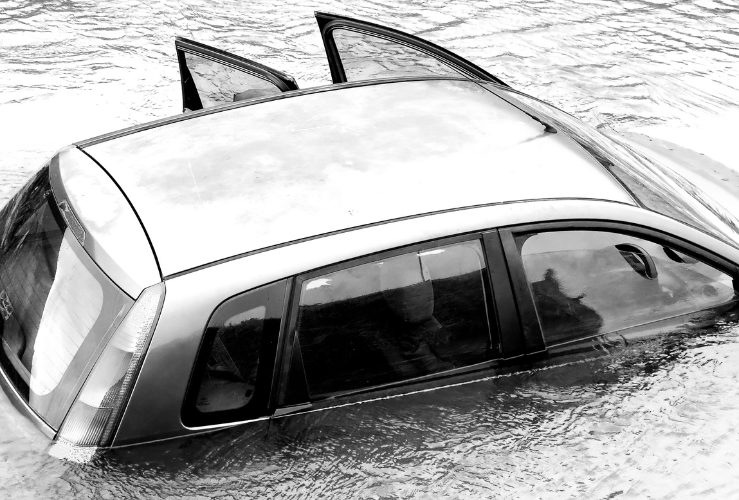
If you can’t escape, wait for the pressure to equalise
On balance, your best option is to escape a vehicle before the water level rises. However, this might not be possible.
If you cannot break the windscreen or open the doors, wait for the water ingress to equalise with the pressure of the water outside. Some say this happens when the water reaches neck level, others when the car is submerged.
You will only have a short period to get out - perhaps 30 seconds.
You'll need to wait until the moment the pressure has equalised or you won’t be able to open the door.
Naturally, this would be a terrifying experience; escaping the vehicle before this point is likely to be the most appropriate course of action.
The famous Top Gear sinking car clip
The BBC's Top Gear filmed a segment in which Richard Hammond attempted to escape from a sinking car by waiting for the water pressure to equalise.
In the event, the door would not open and he was given an oxygen device so he could keep breathing until the pressure did eventually equalise.
If it was for real, he wouldn’t have survived - underlining the fact this is a very last resort.




